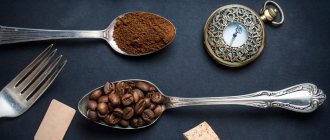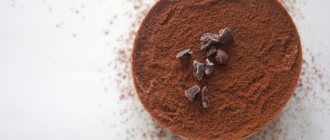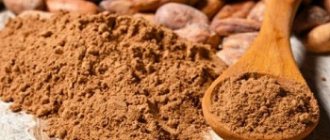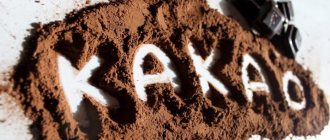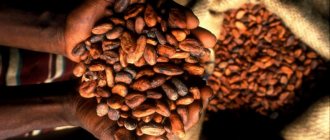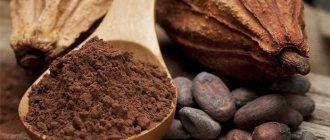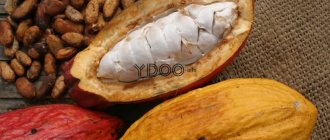Cocoa is a childhood drink. How to cook it to feel that same taste again and share it with your children? One classic recipe, several tricks and modern versions of the drink are in this article. The recipe for classic cocoa is simple:
- 1 tbsp. l. cocoa powder
- 1 tbsp. l. Sahara
- 2 tbsp. l. hot water
- 200 ml milk
Classic mistakes in preparation are pouring all the liquid into the dry powder at once, or even pouring it onto the surface in a floating mound. Instead of a charming drink, you get milk with chocolate lumps.
Cocoa powder is very fine, essentially dust, so making the drink homogeneous is not so easy. The presence of fat in milk prevents the grains from getting wet and complicates the fight against lumps, so in the classic recipe the powder is mixed with a small amount of water to form a liquid paste.
Sugar is added to the powder before adding water. Thanks to the grains, it helps to rub out lumps, so it is more convenient to use than, for example, honey or syrup. The ratio of sugar and cocoa is 50/50, since the powder has a pronounced bitter taste, which has to be softened with a large amount of sweetness. Dark chocolate lovers can reduce the amount of sugar and add a pinch of salt to enhance the flavor.
An important point: cocoa cannot be boiled. In this case, the drink may acquire an unpleasant bitterness, so it is better to cook it over medium heat and remove it as soon as it begins to gurgle and bubble. For the same reason, it needs to be stirred all the time. Grains of powder are heavier than water and milk; if left alone, they will settle to the bottom and immediately begin to burn and become bitter. We'll have to tinker!
Before serving, you can whip the drink to create a velvety foam, or crumble cold butter or cocoa butter onto the surface of the drink to prevent a film from forming as it cools.
So, let’s summarize the three main rules that should be followed when preparing cocoa:
- First dissolve, then add the entire volume
- Stir all the time
- Do not boil
The rest is a matter of technique and taste.
Hot chocolate
- 2 tablespoons cocoa powder
- 200 ml milk
- Tablespoon sugar
- 60 g butter or half a bar of dark chocolate
- 100 ml heavy cream
- Cinnamon to taste
Dilute cocoa and sugar in a small amount of milk. Melt the butter (or chocolate) in a water bath, add cream and cinnamon. Combine cocoa with the remaining milk and put on fire. Without letting it boil, remove from heat and combine with the cream mixture, then simmer over low heat for another couple of minutes, stirring continuously. The finished drink can be decorated with whipped cream.
Hot chocolate has a thicker texture and richer chocolate flavor. The butter in this recipe can be replaced with cocoa butter - it will add additional strength to the aroma of the drink.
Whatever cooking recipe you choose, natural cocoa powder “Golden Label”, which our mothers and grandmothers used, can always be bought in the Alyonka online store with delivery to any region of Russia. Order, experiment and enjoy a tasty and healthy drink from your childhood!
Cocoa is a very healthy and nutritious drink, and at the same time very tasty. We all remember this unsurpassed aroma from childhood. It contains a huge amount of useful substances: lecithin, protein, vitamins A, E, D, etc.
Doctors recommend consuming cocoa for both children and adults, especially those suffering from hypertension. But for this we need to know the correct cooking method.
Advantages and disadvantages of alkalization
Alkalized cocoa powder is much tastier than regular cocoa powder and has a darker, richer, sometimes even reddish color.
After the alkalization process, its acidity decreases, so its taste becomes richer and softer, and it mixes more easily with liquids. Unlike regular cocoa, it does not need to be boiled, but simply poured with hot water or milk.
At the same time, alkalization involves processing cocoa at high temperatures, which results in the loss of some of its beneficial properties. In particular, the percentage of catechins and epicatechins - natural antioxidants. Nevertheless, cocoa itself contains such an amount of these substances valuable for our body that even after the alkalization process, it remains on the list of the richest foods in antioxidants.
There are features of using alkalized cocoa powder for gastronomic purposes - for baking. It must be remembered that if the addition of cocoa is implied in the process of preparing the dough, then you cannot use baking soda. Baking powders are recommended instead, as acid is required to activate the soda.
Cooking method
To prepare this divine drink, we need three tablespoons of cocoa powder, personally I prefer “Golden Label”, about one and a half spoons of sugar, and most importantly one liter of milk.
Bring the milk to a boil over low heat. Then you need to grind the cocoa and sugar so that there are no clots, and pour in a minimum amount of hot milk, stirring generously. Pour the resulting mass into boiling milk and cook over low heat for 2-3 minutes. As a result, we get a very tasty cocoa drink with an appetizing airy foam.
- cocoa - 3 tbsp. spoons;
- sugar - 1.5 tbsp. spoons;
- milk - 1 liter.
Recipe for making cocoa with water
But not everyone likes cocoa made with milk; the most suitable ingredient to replace milk is water. And in this recipe we will tell you how to prepare cocoa with water. For this we need three teaspoons of cocoa, sugar to taste, depends on the amount of water. Bring the water to a boil, first mix the cocoa with sugar and grind until smooth, pour into a saucepan and boil for no more than one minute.
- cocoa - 3 teaspoons;
- sugar to taste;
- water.
How to prepare “Golden Label”?
How to brew cocoa Zolotoy Yarlyk
The method for preparing cocoa drink is quite simple. Another proof of the naturalness of the “Golden Label” product is the fact that it is not enough to simply steam the powder with boiling water; the drink must be boiled. We bring to your attention a couple of simple recipes.
Cocoa "Golden Label" with milk
You will need: 3 tablespoons of cocoa, 1 liter of milk, sugar - to taste.
First of all, you need to put the milk on the fire and bring it to a boil.
Meanwhile, in a separate container, mix cocoa with sugar and add just a little hot water to dilute the mixture without lumps.
Next, mix it with milk and cook for 2 - 3 minutes.
Cocoa "Golden Label" on water
People who are lactose intolerant should not be upset, because cocoa can also be boiled with water.
The preparation procedure in this case does not differ from the first recipe, with the exception of one nuance - we replace the milk with water.
If you find this drink too bland, try using rice or almond milk.
In the video you will find some more interesting recipes with cocoa.
History of cocoa
It is not known for certain who first came up with the idea of using cocoa beans for food, but one thing is for sure - their history lasts for more than one millennium. The cocoa-based drink was known back in the days of the Mayans and Aztecs. Of course, it was not much like a modern drink and had a spicy taste.
It is noteworthy that only a select few had access to the drink and only during special rituals (so the next time you make yourself a cup of cocoa, you can feel like an exceptional person). Aztec leaders even collected beans as taxes.
Cocoa powder was first brought to Europe by Columbus at the beginning of the 16th century. Local nobles did not immediately appreciate the beauty of the drink. Only after the return of one of the conquistadors to Spain, who told the secrets of a wonderful drink that restores strength, did the powder finally gain success.
Its fame increased after the advent of sugar, which significantly improved the taste of the drink. Cocoa began to rapidly spread its influence throughout Europe in the 17th century, after it became available not only to the royal court, but to all wealthy people. And only in the next century, the production of chocolate and cocoa powder, which had previously been ground by hand, was put into production.
The new product was advertised as an excellent remedy with tonic properties and a beneficial effect on memory. In Russia, the chocolate boom began to gain momentum only at the beginning of the 20th century with the advent of Golden Label cocoa in 1908. For a long time, cocoa was associated only with the aristocracy and creative people. But thanks to an advertising campaign that, as in Europe, emphasized its health benefits, soon absolutely everyone loved the drink.
Times change…
But the “Golden Label” remains the same.
Still the same color “from light brown to dark brown”, as required by GOST (and it is still strict).
The same green box with such a recognizable design. No, not quite like that: a window has appeared through which the branded packaging foil can be seen (to protect against counterfeits, of which, unfortunately, the current Russian market is “rich”). And most importantly - the same unique aroma and taste, “peculiar to cocoa powder, without third-party tastes and odors” (and again GOST 108, which has changed very little since the times of the USSR). The most famous Russian is true to traditions.
We hope that this article was useful to you, we will be grateful if you share it with your friends on social media. networks. Have a nice day and see you again!
Characteristics of Golden Label cocoa
Cocoa powder "Golden Label" is of high quality and is made exclusively from natural ingredients. Traditionally, Red October used only cocoa powder in its product. This was a great advantage over competitors who used synthetic components. Recently, Vanilla flavoring has been added to the Golden Label cocoa powder. This slightly lowered the bar for the product, although the fact that the powder was prepared exclusively from natural beans remained unchanged.
As for the energy composition, the following should be mentioned:
- Proteins – 24 g.
- Fats – 15 g.
- Carbohydrates – 10 g.
Please note that the amount of fat indicates the naturalness of the product. If you see the number 11 or even less on the packaging of other manufacturers, you should know that it doesn’t even smell like real cocoa beans.
“Golden Label” should be stored at a temperature no higher than 21 degrees and no lower than 15, otherwise the powder will quickly lose its taste and beneficial qualities. Available in packs of 100 g.
At some point, the production of cocoa by “Red October” ceased, but in 2009 the production of “Golden Label” products was resumed. Unfortunately, during this time a lot of counterfeit goods appeared. Therefore, it is very important to distinguish a certified product from a counterfeit and buy cocoa either in Red October branded stores or in large chain stores.
Attention! The fake looks like this:
- Matte box.
- Dim colors of the pack and logo.
- Uneven and/or colored embossing of the date of manufacture.
- There are errors in the information you provide, such as your email address.
- Weight is usually less than 108 grams.
- Letters on foil are less readable and bright.
- The powder does not dissolve and does not have a pronounced chocolate taste.
“Red October” changed the design of the packaging, adding a window on the side of the package and adding straight lines to the design, but you should not focus only on these indicators.
How to determine the authenticity of Golden Label cocoa
Unfortunately, cocoa powder is one of those products that is very often counterfeited. Special insignia on the product packaging will help distinguish the original “Golden Label” product from a counterfeit.
Cocoa powder from the Red October confectionery factory differs from a fake in the following:
- On the right side of the cardboard package, immediately below the recipe for making the drink, there is an oval window.
- Cocoa powder is packaged first in a separate inner bag and then in a cardboard package. Through the window you can see the “Golden Label” and “Red October” logos on the package.
- The cardboard packaging has a traditional emerald color with gold ornaments and the factory logo on a red background.
- The quality of the product is confirmed by the GOST 108 sign applied to the packaging.
When you open the inner bag, real cocoa powder has a rich aroma of natural cocoa beans and light notes of vanilla. There should be no bitterness or other suspicious odors.
Nutritional value and chemical composition
The table shows the nutritional content (calories, proteins, fats, carbohydrates, vitamins and minerals) per 100 grams of edible portion.
| Nutrient | Quantity | Norm** | % of the norm in 100 g | % of the norm in 100 kcal | 100% normal |
| Calorie content | 356.9 kcal | 1684 kcal | 21.2% | 5.9% | 472 g |
| Squirrels | 24.2 g | 76 g | 31.8% | 8.9% | 314 g |
| Fats | 16 g | 56 g | 28.6% | 8% | 350 g |
| Carbohydrates | 27.9 g | 219 g | 12.7% | 3.6% | 785 g |
| Alimentary fiber | 35.3 g | 20 g | 176.5% | 49.5% | 57 g |
| Water | 5 g | 2273 g | 0.2% | 0.1% | 45460 g |
| Vitamins | |||||
| Vitamin A, RE | 3 mcg | 900 mcg | 0.3% | 0.1% | 30000 g |
| Beta carotene | 0.02 mg | 5 mg | 0.4% | 0.1% | 25000 g |
| Vitamin B1, thiamine | 0.1 mg | 1.5 mg | 6.7% | 1.9% | 1500 g |
| Vitamin B2, riboflavin | 0.2 mg | 1.8 mg | 11.1% | 3.1% | 900 g |
| Vitamin B5, pantothenic | 1.5 mg | 5 mg | 30% | 8.4% | 333 g |
| Vitamin B6, pyridoxine | 0.3 mg | 2 mg | 15% | 4.2% | 667 g |
| Vitamin B9, folates | 45 mcg | 400 mcg | 11.3% | 3.2% | 889 g |
| Vitamin E, alpha tocopherol, TE | 0.3 mg | 15 mg | 2% | 0.6% | 5000 g |
| Vitamin RR, NE | 6.8 mg | 20 mg | 34% | 9.5% | 294 g |
| Macronutrients | |||||
| Potassium, K | 1509 mg | 2500 mg | 60.4% | 16.9% | 166 g |
| Calcium, Ca | 128 mg | 1000 mg | 12.8% | 3.6% | 781 g |
| Magnesium, Mg | 425 mg | 400 mg | 106.3% | 29.8% | 94 g |
| Sodium, Na | 13 mg | 1300 mg | 1% | 0.3% | 10000 g |
| Sera, S | 80 mg | 1000 mg | 8% | 2.2% | 1250 g |
| Phosphorus, Ph | 655 mg | 800 mg | 81.9% | 22.9% | 122 g |
| Chlorine, Cl | 28 mg | 2300 mg | 1.2% | 0.3% | 8214 g |
| Microelements | |||||
| Iron, Fe | 22 mg | 18 mg | 122.2% | 34.2% | 82 g |
| Manganese, Mn | 4.625 mg | 2 mg | 231.3% | 64.8% | 43 g |
| Copper, Cu | 4550 mcg | 1000 mcg | 455% | 127.5% | 22 g |
| Molybdenum, Mo | 56 mcg | 70 mcg | 80% | 22.4% | 125 g |
| Fluorine, F | 245 mcg | 4000 mcg | 6.1% | 1.7% | 1633 g |
| Zinc, Zn | 7.1 mg | 12 mg | 59.2% | 16.6% | 169 g |
Beneficial features
Cocoa powder “Golden Label” is rich in vitamins and minerals such as: vitamin B2 - 11.1%, vitamin B5 - 30%, vitamin B6 - 15%, vitamin B9 - 11.3%, vitamin PP - 34%, potassium - 60.4%, calcium - 12.8%, magnesium - 106.3%, phosphorus - 81.9%, iron - 122.2%, manganese - 231.3%, copper - 455%, molybdenum - 80% , zinc - 59.2%.
Benefits of cocoa powder “Golden Label”:
- Vitamin B2 is involved in redox reactions, helps to increase the color sensitivity of the visual analyzer and dark adaptation. Insufficient intake of vitamin B2 is accompanied by impaired condition of the skin, mucous membranes, and impaired light and twilight vision.
- Vitamin B5 is involved in protein, fat, carbohydrate metabolism, cholesterol metabolism, the synthesis of a number of hormones, hemoglobin, promotes the absorption of amino acids and sugars in the intestines, and supports the function of the adrenal cortex. A lack of pantothenic acid can lead to damage to the skin and mucous membranes.
- Vitamin B6 is involved in maintaining the immune response, processes of inhibition and excitation in the central nervous system, in the transformation of amino acids, the metabolism of tryptophan, lipids and nucleic acids, promotes the normal formation of red blood cells, and maintaining normal levels of homocysteine in the blood. Insufficient intake of vitamin B6 is accompanied by decreased appetite, impaired skin condition, and the development of homocysteinemia and anemia.
- Vitamin B9 as a coenzyme is involved in the metabolism of nucleic acids and amino acids. Folate deficiency leads to disruption of the synthesis of nucleic acids and proteins, resulting in inhibition of cell growth and division, especially in rapidly proliferating tissues: bone marrow, intestinal epithelium, etc. Insufficient folate intake during pregnancy is one of the causes of prematurity, malnutrition, and congenital deformities and child development disorders. A strong relationship has been shown between folate and homocysteine levels and the risk of cardiovascular disease.
- Vitamin PP is involved in redox reactions of energy metabolism. Insufficient vitamin intake is accompanied by disruption of the normal condition of the skin, gastrointestinal tract and nervous system.
- Potassium is the main intracellular ion that takes part in the regulation of water, acid and electrolyte balance, and is involved in the processes of conducting nerve impulses and regulating blood pressure.
- Calcium is the main component of our bones, acts as a regulator of the nervous system, and is involved in muscle contraction. Calcium deficiency leads to demineralization of the spine, pelvic bones and lower extremities, increasing the risk of developing osteoporosis.
- Magnesium is involved in energy metabolism, the synthesis of proteins, nucleic acids, has a stabilizing effect on membranes, and is necessary to maintain the homeostasis of calcium, potassium and sodium. A lack of magnesium leads to hypomagnesemia, an increased risk of developing hypertension and heart disease.
- Phosphorus takes part in many physiological processes, including energy metabolism, regulates acid-base balance, is part of phospholipids, nucleotides and nucleic acids, and is necessary for the mineralization of bones and teeth. Deficiency leads to anorexia, anemia, and rickets.
- Iron is part of proteins with various functions, including enzymes. Participates in the transport of electrons and oxygen, ensures the occurrence of redox reactions and activation of peroxidation. Insufficient consumption leads to hypochromic anemia, myoglobin deficiency atony of skeletal muscles, increased fatigue, myocardiopathy, and atrophic gastritis.
- Manganese is involved in the formation of bone and connective tissue, and is part of enzymes involved in the metabolism of amino acids, carbohydrates, and catecholamines; necessary for the synthesis of cholesterol and nucleotides. Insufficient consumption is accompanied by slower growth, disturbances in the reproductive system, increased fragility of bone tissue, and disturbances in carbohydrate and lipid metabolism.
- Copper is part of enzymes that have redox activity and are involved in the metabolism of iron, stimulates the absorption of proteins and carbohydrates. Participates in the processes of providing oxygen to the tissues of the human body. Deficiency is manifested by disturbances in the formation of the cardiovascular system and skeleton, and the development of connective tissue dysplasia.
- Molybdenum is a cofactor for many enzymes that ensure the metabolism of sulfur-containing amino acids, purines and pyrimidines.
- Zinc is part of more than 300 enzymes and is involved in the processes of synthesis and breakdown of carbohydrates, proteins, fats, nucleic acids and in the regulation of the expression of a number of genes. Insufficient consumption leads to anemia, secondary immunodeficiency, liver cirrhosis, sexual dysfunction, and the presence of fetal malformations. Research in recent years has revealed the ability of high doses of zinc to disrupt the absorption of copper and thereby contribute to the development of anemia.
Harm and contraindications
It would seem that with so many positive properties and qualities, cocoa simply cannot have any disadvantages. However, under certain conditions, negative consequences of cocoa consumption for the body can be observed. Cocoa contains, albeit a small amount of caffeine (0.2%). The mild stimulating effect of the drink can aggravate problems with falling asleep if you drink cocoa before bed.
Cocoa beans contain purines, which, being an essential component of nucleic acids responsible for the storage and transmission of genetic information, when in excess of the body, contribute to the accumulation of uric acid in the body, the deposition of salts in the joints, and the occurrence of kidney and bladder diseases.
People who have a history of:
- gout,
- diabetes,
- sclerosis,
- atherosclerosis,
- diarrhea,
- urolithiasis.
Due to its high calorie content, the drink is also not recommended for overweight people. Due to the high content of tannins, people suffering from constipation should not drink cocoa.
The method of processing, storing and transporting cocoa beans is particularly dangerous. Unfortunately, in those countries where the chocolate tree grows, sanitary conditions leave much to be desired, which also affects the quality of the final product.
Suffice it to mention that cocoa beans are a favorite habitat of cockroaches, which can be very difficult to get rid of... And the chitin of these insects can cause allergic reactions in people. In addition, cocoa is one of the most pesticide-treated crops in the world.
Product test reports and test results
- safe;
- no pesticides;
- made from cocoa beans.
- unreliable information about fat content, it is 13% more.
Cocoa powder “Red October / Golden Label” meets safety requirements according to proven indicators.
A fact of inconsistency with the name and composition of the product was revealed (starch, unusual for this type of product, was identified). Fat content is 13% higher than stated.
Does not comply with GOST 108-2014 in composition - starch was identified that is not typical for this product. Complies with GOST 108-2014 for tested organoleptic and physico-chemical indicators (developed according to GOST 108-2014).
The product was tested by Roskontrol in 2021: no comments.
Glorious Past
After the revolution, Einem was nationalized and given the name it bears to this day - Red October. Sweets and chocolates began to be produced under new, Soviet names. But they decided not to touch the now classic brand. And the most famous cocoa powder in the USSR, as before, was called “Golden Label”. This popularity is not surprising: the product is excellent! No wonder its name quickly became synonymous with the best type of chocolate drink. The inexorable Soviet GOST established the most stringent requirements for its quality.
What's the secret? Unlike such well-known varieties of Soviet cocoa as “Extra” and “Silver Label”, the raw materials for the “Golden Label” were not subjected to alkaline treatment (such varieties are called unprepared). The taste of the prepared powder can be more pronounced and the color brighter. And it forms a better suspension in water, “dissolving” with a minimum of sediment. Made strictly according to GOST, this drink is quite good. But it does not have the sophistication and harmony that is characteristic of the famous variety. Yes, and useful substances are noticeably destroyed during such processing.
A modern Russian buyer would be surprised to go to a 1930s USSR-era grocery store and not see such a familiar green box there. The famous cocoa powder was then produced in dark purple cans with gold ornaments. And the packaging of this drink acquired its familiar form at the dawn of the 1960s.
Cooking method
Below are several recipes on how to prepare Golden Label cocoa.
With milk in Turk
You can brew cocoa according to the traditional recipe in a Turk or any other enamel container. A drink prepared in this way has the most intense taste and exquisite aroma. It can be compared to real coffee brewed in a Turk.
Step-by-step preparation of the drink occurs in the following sequence. Pour 1 ½ teaspoons of powder from the pack and 1 teaspoon of sugar into the Turk. Grind all the lumps well until the mixture is homogeneous. Pour the prepared mixture with warm milk (200 ml).
Place the Turk on the stove over the lowest heat. Carefully ensure that the drink does not escape. As soon as the foam begins to rise, the Turk should be immediately removed from the heat. Cocoa can be drunk hot or cold. As a dessert, it is recommended to serve the drink with ice cream.
On the water
Cocoa drink brewed with water is no less tasty. Its preparation occurs in the following sequence:
- Sugar and powder from the pack (1 ½ teaspoons each) are poured into an enamel container. It is important that there are no lumps, otherwise it will negatively affect the taste of the drink.
- Pour some hot water into the cocoa and sugar mixture and mix the ingredients well.
- Pour hot water to the 200 ml mark, put the container on the fire and bring the drink to a boil.
- Cook it on the stove for about two minutes, stirring regularly.
- It is advisable to drink a cocoa drink made with water hot.
On rice water
What if you really want to taste a chocolate drink, but you are not allowed to drink milk? “Golden Label” cocoa powder, the composition of which has never been burdened with extraneous additives, allows you to prepare a drink that is allowed for consumption during Orthodox fasts. For it, rice water is used instead of milk. They do it as follows.
Pour 10 g of rice into 300 ml of water and cook. Drain the cereal in a colander and use the broth for a drink. Grind 5 g of cocoa and 10 g of sugar in a metal saucepan, add a little broth and stir well to a paste. Pour in the remaining broth, stirring the mixture until completely homogeneous. Bring to a boil.
Hot mocha with chocolate
“Golden Label” is the highest grade cocoa. The finest grinding makes it possible to experiment with different ingredients. The given recipe is designed for a large company - about eight people.
- In a large metal saucepan, combine cocoa (1 cup), granulated sugar (1 cup), dry instant coffee powder (quarter cup), vanilla (1 packet) and a pinch of salt.
- Bring to a homogeneous paste by pouring hot water (1 cup) in small portions.
- Place on the fire and, stirring constantly, pour in hot milk (6 cups) and cream (2 cups).
- Bring to a boil, pour the prepared drink into mugs.
Brewing the drink with milk or water is an individual choice. It all depends on taste preferences and health status.
